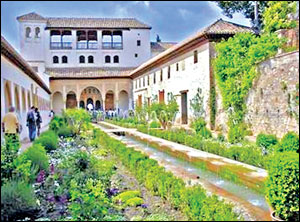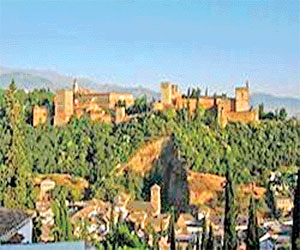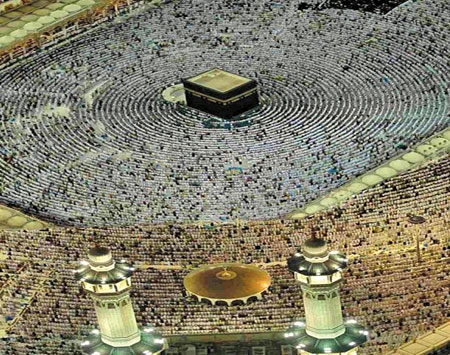|
ISLAM
Muslim Spain - Gem of Europe
Golden era of religious harmony,
economic, intellectual and scientific prosperity
Dean Derhak
With the arrival of the Muslims in Spain, the once arid and
illiterate land became the capital of European scholarship and
agriculture, where people of all faiths were granted security under
Muslim rule.

When you think of European culture, one of the first things that may
come to your mind is the renaissance. Many of the roots of European
culture can be traced back to that glorious time of art, science,
commerce and architecture. But did you know that long before the
renaissance there was a place of humanistic beauty in Muslim Spain? Not
only was it artistic, scientific and commercial, but it also exhibited
incredible tolerance, imagination and poetry.
Muslims populated Spain for nearly 700 years. As you’ll see, it was
their civilization that enlightened Europe and brought it out of the
dark ages to usher in the renaissance. Many of their cultural and
intellectual influences still live with us today.
Way back during the eighth century, Europe was still knee-deep in the
Medieval period. That’s not the only thing they were knee-deep in. In
his book, “The Day The Universe Changed,” the historian James Burke
describes how the typical European townspeople lived: The inhabitants
threw all their refuse into the drains in the centre of the narrow
streets. The stench must have been overwhelming, though it appears to
have gone virtually unnoticed. Mixed with excrement and urine would be
the soiled reeds and straw used to cover the dirt floors. (p. 32)
This squalid society was organized under a feudal system and had
little that would resemble a commercial economy. Medieval Europe was a
miserable lot, which ran high in illiteracy, superstition, barbarism and
filth.
During this same time, Muslims entered Europe from the South. Abd al-Rahman
I, a survivor of a family of Caliphs of the Muslim empire, reached Spain
in the mid-700s. He became the first Caliph of Al-Andalus, Spain, which
occupied most of the Iberian Peninsula. He also set up the Umayyad
Dynasty that ruled Al-Andalus for over three-hundred years. (Grolier,
History of Spain).
At first, the land resembled the rest of Europe in all its squalor.
But within two-hundred years the Muslims had turned Al-Andalus into a
bastion of culture, commerce and beauty. “Irrigation systems imported
from Syria turned the dry plains into an agricultural cornucopia. Olives
and wheat had always grown there. The Muslims added pomegranates,
oranges, lemons, aubergines, artichokes, cumin, coriander, bananas,
almonds, pams, henna, woad, madder, saffron, sugar-cane, cotton, rice,
figs, grapes, peaches, apricots and rice.” (Burke, 1985, p. 37)
By the beginning of the ninth century, Muslim Spain was the gem of
Europe with its capital city, Cordova. With the establishment of Abd al-Rahman
III - “the great caliphate of Cordova” - came the golden age of Al-Andalus.
Cordova, in southern Spain, was the intellectual centre of Europe.
At a time when London was a tiny mud-hut village that “could not
boast of a single streetlamp” (Digest, 1973, p. 622), in
Cordova...”...there were half a million inhabitants, living in 113,000
houses. There were 700 mosques and 300 public baths spread throughout
the city and its twenty-one suburbs.The streets were paved and lit.”
(Burke, 1985, p. 38)
“The houses had marble balconies for summer and hot-air ducts under
the mosaic floors for the winter. They were adorned with gardens with
artificial fountains and orchards”. (Digest, 1973, p. 622) “Paper, a
material still unknown to the west, was everywhere. There were bookshops
and more than seventy libraries.” (Burke, 1985, p. 38).
|

Al Hambra Palace -Granada |
In his book titled, “Spain In The Modern World,” James Cleuge
explains the significance of Cordova in Medieval Europe:”For there was
nothing like it, at that epoch, in the rest of Europe. The best minds in
that continent looked to Spain for everything which most clearly
differentiates a human being from a tiger.” (Cleugh, 1953, p. 70)
During the end of the first millennium, Cordova was the intellectual
well from which European humanity came to drink. Students from France
and England travelled there to sit at the feet of Muslim, Christian and
Jewish scholars to learn philosophy, science and medicine (Digest, 1973,
p. 622). In the great library of Cordova alone, there were some 600,000
manuscripts (Burke, 1978, p. 122).
This rich and sophisticated society took a tolerant view towards
other faiths. Tolerance was unheard of in the rest of Europe. But in
Muslim Spain, “thousands of Jews and Christians lived in peace and
harmony with their Muslim overlords.” (Burke, 1985, p. 38)
Unfortunately, this period of intellectual and economic prosperity
began to decline. Shifting away from the rule of law, there began to be
internal rifts in the Muslim power structure. The Muslim harmony began
to break up into warring factions. Finally, the Caliphs were eliminated
and Cordova fell to other Muslim forces.
“In 1013 the great library in Cordova was destroyed. True to their
Islamic traditions however, the new rulers permitted the books to be
dispersed, together with the Cordovan scholars to the capital towns of
small emirates.” (Burke, 1985, p. 40) The intellectual properties of the
once great Al-Andalus were divided among small towns.
...the Christians to the North were doing just the opposite. In
Northern Spain the various Christian kingdoms united to expel the
Muslims from the European continent. (Grolier, History of Spain) This
set the stage for the final act of the Medieval period.
In another of James Burke’s works titled “Connections,” he describes
how the Muslims thawed out Europe from the Dark Ages. “But the event
that must have done more for the intellectual and scientific revival of
Europe was the fall of Toledo in Spain to the Christians, in 1105.” In
Toledo the Muslims had huge libraries containing the lost (to Christian
Europe) works of the Greeks and Romans along with Muslim philosophy and
mathematics. “The Spanish libraries were opened, revealing a store of
classics and Muslim works that staggered Christian Europeans.” (Burke,
1978, p. 123)
The intellectual plunder of Toledo brought the scholars of northern
Europe like moths to a candle. The Christians set up a giant translating
program in Toledo. Using the Jews as interpreters, they translated the
Muslim books into Latin. These books included “most of the major works
of Greek science and philosophy... along with many original Muslim works
of scholarship.” (Digest, p. 622)
“The intellectual community which the northern scholars found in
Spain was so far superior to what they had at home that it left a
lasting jealousy of Muslim culture, which was to color Western opinions
for centuries” (Burke, 1985, p. 41)
“The subjects covered by the texts included medicine, astrology,
astronomy , pharmacology, psychology, physiology, zoology, biology,
botany, mineralogy, optics, chemistry, physics, mathematics, algebra,
geometry, trigonometry, music, meteorology, geography, mechanics,
hydrostatics, navigation and history.” (Burke, 1985, p. 42)
These works alone however, didn’t kindle the fire that would lead to
the renaissance. They added to Europe’s knowledge, but much of it was
unappreciated without a change in the way Europeans viewed the world.
|

The great Mosque-Cordoba |
Remember, Medieval Europe was superstitious and irrational. “What
caused the intellectual bombshell to explode, however, was the
philosophy that came with (the books).” (Burke, 1985, p. 42)
Christians continued to re-conquer Spain, leaving a wake destruction
in their path. The books were spared, but Moor culture and their
civilization was disintegrated. Ironically, it wasn’t just the strength
of the Christians that defeated the Muslims but the disharmony among the
Muslims’ own ranks.
Like Greece and Rome that preceded them, the Muslims of Al-Andalus
fell into moral decay and wandered from the intellect that had made them
great.
The translations continued as each Muslim haven fell to the
Christians. In 1492, the year Columbus discovered the New World,
Granada, the last Muslim enclave, was taken. Captors of the knowledge
were not keepers of its wisdom. Sadly, all Jews and Muslims that would
not abandon their beliefs were exiled (Grolier, History of Spain). Thus
ended an epoch of tolerance and all that would remain of the Muslims
would be their books.
It’s fascinating to realize just how much Europe learned from the
Muslim texts and even greater to see how much that knowledge has
endured. Because of the flood of knowledge, the first Universities
started to appear. College and University degrees were developed (Burke,
1985, p. 48).
Directly from the Muslims came the numerals we use today. Even the
concept of Zero (a Muslim word) came from the translations (Castillo &
Bond, 1987, p. 27). It’s also fair to say that renaissance architectural
concepts came from the Muslim libraries.
Mathematics and architecture explained in the Muslim texts along with
Muslim works on optics led to the perspective paintings of the
renaissance period (Burke, 1985 p. 72).
The first lawyers began their craft using the new translated
knowledge as their guide. Even the food utensils we use today come from
the Cordova kitchen! (Burke, 1985 p. 44) All of these examples show just
some of the ways Europe transformed from the Muslims.
The Muslims, though, left a lasting legacy for Spain did not simply
occupy the country; as Washington Irving wrote in his ‘Tales of the
Alhambra’, they were not’invaders and usurpers’ but ‘rediscoverers of
the Greek reservoir of knowledge’ and helped plant the roots of the
European Renaissance. Obviously the great palaces, castle and mosques of
Moorish times are amongst Spain’s greatest tourist attractions. So too
were the irrigation systems that enabled the dry plains to be
efficiently farmed.
|

View of Alhambra |
So too were the narrow, labyrinthine street plans of many of the old
towns. Even the flamenco itself has clear Islamic origins. The Spanish
language is similarly full of words of Arabic origin - arroz (rice),
alcalde(mayor), naranja(orange), az£car(sugar) being just simple
examples.
Architecturally, there is evidence of the Muslim influence throughout
much of Spain. Horseshoe-shaped arches, the decorative use of tiles, the
design of peaceful inner courtyards, complex stucco work and almost
stalactite-type ceiling embellishments are all part of the Muslim
tradition.
The best places to visit for examples are obviously C¢rdoba, where
there were once 1600 mosques and where the Mezquita is guaranteed to
enthral you; Granada, with the Alhambra, surely one of the world’s most
beautiful places; Sevilla, in particular the minaret known as the
Giralda and the Alc zar - a masterpiece of Islamic architecture built,
ironically, for a Christianking, Pedro I; and, in the north, the Palace
of the Alijafer¡a in Zaragoza.
It’s amazing how much of what we consider to be ‘the real Spain’ is
part of Spain’s Muslim legacy.
Amazing discipline inculcated by Islam
Around three million Muslims gather at Masjid Al Haram, the largest
Masjid in the holy city of Makka during the holy month of Ramadhan
fasting during the annual Hajj season.
|

Muslims praying in orderly lines in the Masjid in Makka |
They come from all over the world. They belonged to different
countries, races, cultures, languages, food habits and even clothings.
However the amazing sight is that they gathered into neat lines within
minutes, as if they were taught to do so.
Once in the program called ONE FAMILY on MAJD channel, the speaker
Dr.Yahya
Al yahya -head of the call to Islam Committee, told about a story of
an American man who was discussing about Islam while watching live night
prayers from Ka’bah on the television.,
The American man was amazed at how crowded the Masjid was. More than
three million Muslims gathered in the last nights of the holy month of
Ramadan.
The sheikh asked the American: How long do you think they’ll take to
organize themselves in orderly lines pointing out that the masjid of
Kaaba is four floors. The man said: Oh! this will make it about 12
hours.
The sheikh said: put in your mind that they are from countries all
over the world speaking different languages.
The American man said: then its impossible to organize them by any
means.
Then came the prayer time and sheikh Sudais of Makkah stood up and
asked the worshippers to arrange themselves. Within seconds the whole
scene changed and the crowd of around three million Muslims arranged
themselves into well-organized lines in no time!
The American was stunned.
Fear of ‘Caliph Umar
It would be no exaggeration to say that the Ameer-ul-Mu’mineen ‘Umar
bin al-Khattab R.A, known as Caliph Umar, was so much feared by the
Muslims that once he heard a group of men talking about a certain lady.
So Caliph ‘Umar wanted to know about this Muslimah and thus he
summoned for her. This Muslimah was pregnant and when she saw Caliph
‘Umar R.A she realised she had a miscarriage!
Once Caliph Umar was getting his hair cut suddenly he coughed and
because of this the barber urinated on himself because of the fear.
The other companion got to know about this incident and ‘Uthman bin
‘Affan, ‘Ali bin Abi Talib, ‘Abdur Rahman ibn ‘Awf, Az-Zubayr bin ‘Awwam
gathered to discuss this issue about the immense fear of Caliph Umar R.A
in the hearts of the believers. They came up with the idea that they
will choose from themselves a person who would go and speak to Caliph
Umar about it and the boldest of them was ‘Abdur Rahman ibn ‘Awf thus he
was sent.
He went to Caliph Umar and told him how much the believers feared
him. Caliph Umar responded, “O’ ‘Abdur Rahman, sometimes I feel that I
am too strict so I soften whilst sometimes I feel that I am too lenient
so I become strict I don’t know what will happen of me when I meet Allah
SWT!”
Hearing this, ‘Abdur Rahman started weeping and left saying, “Woe to
you O’ Ummah of Muhammad, what will happen to you when you (‘Umar) will
leave!” People fear Caliph who wept for the fear of Allah.
This is the very same Caliph Umar who captured Jerusalem and built up
an Islamic empire covering a vast area.
His rule is known for justice and simplicity.
If only an iota of this fear is there among today’s so called modern
rulers of United States, Britain, France and other countries the world
will certainly be a peaceful place where millions of people who,
otherwise being killed for reasons all over the world, would live in
peace and harmony.
Secrets of divine operations
ONCE Nabi Musaa, Prophet Moses, supplicated to Allah to reveal some
of His secrets and mysteries which underlie the Wisdom of His
operations.
Allah instructed Nabi Musaa to proceed to a certain venue in the
wilderness. The area in the wilderness where he went was an oasis.
There was a fountain of water and a clump of trees. He sat down
concealing himself among the trees. Soon a horse-rider appeared. He
stopped by the fountain. Alighted and drank from the water. After
resting for a while, he departed, forgetting his bag of gold coins at
the spot. After his departure, appeared a youth. The youth drank some
water, saw the bag of gold coins and promptly took the bag and left.
Then appeared a man with a bundle of wood on his head. This person
was a slave. The slave put down his bundle, drank of the water and fell
asleep besides his bundle of wood.
While he was asleep, the horse-rider who had discovered that his
treasure was missing, returned in haste.
When he did not see his treasure-bag, he was overwhelmed with grief
and anger. He concluded that it could only have been this slave who had
taken and hidden his gold. He struck the slave with his whip. The
slave’s eyes opened, and the rider demanded his treasure. The slave
denied all knowledge of the bag and protested his innocence. The
protestation and pleas of the slave did not convince him. In anger he
drew his sword and killed the slave. Nabi Musaa was astonished at this
series of events. He was intrigued by the ostensible injustice which
played out in front of him. Then Allah revealed the mystery underlying
this episode of seemingly inexplicable injustice.
The horse-rider was an employee of a very wealthy person. He had
stolen the gold from the wealthy man who was the father of the youth.
The father had died. In this mysterious way Allah restored the gold to
its rightful owner, the youth.
Page compiled by
Latheef Farook.
Email [email protected]
|



